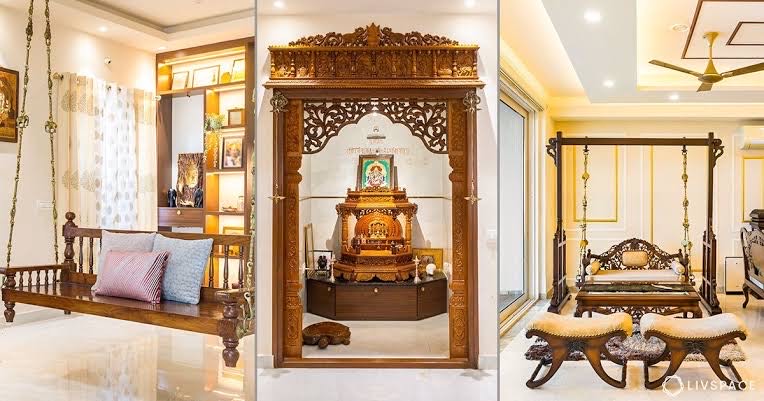In an era where minimalism has become too mainstream, homeowners and women who are often vested with the responsibility to revamp their homes are not hesitating to be different from the rest and choose designs that celebrate their distinct and beautifully subtle choices. Today, homeowners are looking for opportunities to share their individuality and turning back to the roots of traditional Indian art and craft, could be one of many ways to do that. These intricate and timeless designs, born out of centuries of culture, craftsmanship and heritage, are seeing a remarkable resurgence in contemporary spaces. Today, as the lines blur between tradition and innovation, these heritage-inspired designs which extend as an ode to India’s rich art and tradition — are proving their relevance and timeless appeal, creating interiors that feel personal, meaningful, and deeply connected to the past.
Taking design cues from grand maharaja palaces
Indian palaces, with their tales of royalty and splendor, remain one of the most celebrated sources of inspiration for interior design. Their architectural brilliance, filled with intricate arches, detailed motifs and luxurious ornamentation, continues to inspire modern aesthetics. But what sets this influence apart today is the ability to reinterpret such grandeur for contemporary spaces. Designs like Gajamudra, Vasantha and Sanskriti exemplify this balance beautifully.
Take Gajamudra, inspired by the royal elephant, a timeless emblem of strength and grace in Indian heritage. Its subtle finish exudes understated sophistication. Vasantha captures the lush beauty of palace gardens, infusing interiors with a serene, nature-inspired elegance. Sanskriti celebrates intricate cultural motifs from historic palaces, reimagined in versatile hues for contemporary spaces. Together, these designs blend regal grandeur with modern refinement.
Imbibing the elegance of chikankari
On the other end of the spectrum lies the subtle elegance of Chikankari embroidery. This delicate craft, native to India, has long been celebrated for its finesse and intricacy. In the context of interiors, Chikan Kari-inspired patterns add depth, texture, and a sense of quiet sophistication to spaces. Designs like Alankrit, Karnika, and Jharokha bring this artistry to life, transforming walls, cabinets, and furniture into understated masterpieces. Alankrit draws from the intricate charm of hand-embroidered fabrics, with its linen-like finish adding soft, subtle texture. Karnika, inspired by traditional Indian earrings, brings grace and poise to modern designs. Jharokha reflects the grand arches of Indian havelis, adding timeless architectural elegance. These patterns beautifully balance tradition and modernity, enhancing interiors with understated sophistication. Perfect for those who favor quiet elegance, Chikankari-inspired designs seamlessly blend charm and restraint.
Ikkat stands out from the rest
For the bold and adventurous, few Indian art forms match the vibrancy and dynamism of Ikkat. Known for its striking patterns and lively color palette, Ikkat has long been a symbol of artisanal craftsmanship. Today, this iconic weaving technique has been reimagined in modern materials, making it accessible and adaptable to contemporary interiors.
Jhoomar reflects the timeless charm of traditional Ikkat with a finish that exudes depth and elegance. Sutra celebrates the intricate threadwork of Ikkat, while Taranga evokes the calming flow of ocean waves. Tarang Pushp blends the grace of blooming flowers with the rhythmic beauty of waves, offering a perfect balance of heritage and modernity. Bringing traditional Indian art into modern interiors isn’t merely about aesthetics. It’s about creating spaces that resonate with emotion, identity, and history. These heritage-inspired designs tell stories. They evoke memories of family homes, festivals and cherished moments while connecting us to the larger cultural possibilities of India.
End Note
Moreover, as sustainability becomes an integral part of interior design, these traditional influences carry an inherent value. They remind us of the importance of craftsmanship, the beauty of handmade work and the need to preserve these art forms for future generations. Through incorporating traditional designs into modern spaces, we’re not only honoring our heritage but also supporting the artisans and craftspeople who keep these traditions alive. Ultimately, the revival of traditional Indian designs in today’s interiors is about more than just decoration. It’s about creating homes that feel authentic, meaningful, and connected to something larger than ourselves. These designs offer a way to celebrate our heritage while welcoming the future. And in doing so, they remind us that while styles may change, the beauty of tradition is truly timeless.
(The author, Manoj Lohia, is the Director, is Merino Industries Ltd.)




